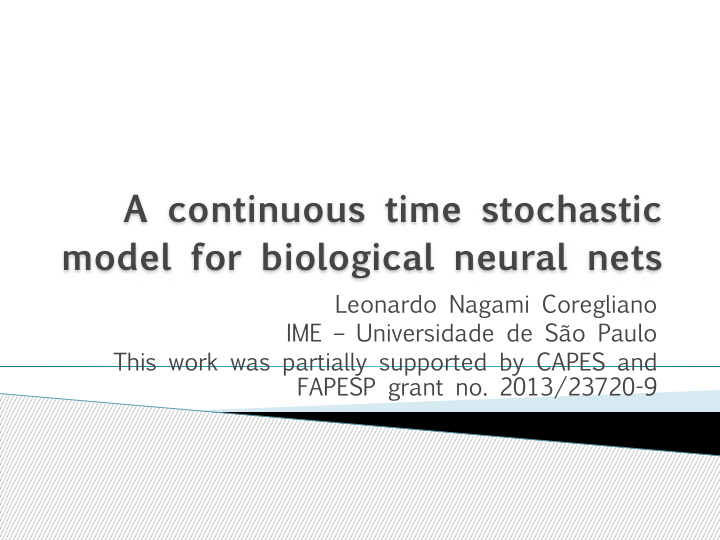



A continuous time stochastic model for biological neural nets Leonardo Nagami Coregliano IME – Universidade de São Paulo This work was partially supported by CAPES and FAPESP grant no. 2013/23720-9
Our main goals � To model mathematically a biological neural net as a continuous time stochastic process (to extend a model by Galves & Löcherbach (2013) from discrete time to continuous time); ◦ Has been done by Duarte & Ost (2014). � To study this model. ◦ Does the system “die”? ◦ How does the system “die”?
Our approach (our subgoal) � To produce a model that can be easily simulated. ◦ Stochastic differential equation (Duarte & Ost) approach does not work; ◦ Adapt the discrete time model to continuous time by adapting one of its simulation algorithms to continuous time; ● Downside: our model is not as general; ● Upside: model’s existence comes for free.
The model �
The model must make sense... �
The simulation algorithm � Instead of computing whether a neuron fires or not, we compute the waiting time for it to fire; ◦ Involves calculating the inverse of a cumulative distribution function. Potential Waiting time Time t = 3 3.3 2 7.2 1.5 4.9 5 ∞ 0 ∞ 3.2
The simulation algorithm � Instead of computing whether a neuron fires or not, we compute the waiting time for it to fire; ◦ Involves calculating the inverse of a cumulative distribution function. Potential Waiting time Potential Potential Time t = 3 Time Time t = 4.5 3.3 2 0.825 1.825 7.2 1.5 1.8 0 4.9 5 1.225 2.225 ∞ 0 0 1 ∞ 3.2 0.8 1.8
Studying the model �
A theorem on system death �
A theorem on system death Sick Healthy neurons neurons � The system dies in finite time with positive probability if and only if there is no cycle on the healthy neurons. � Furthermore, if the system dies in finite time with positive probability, then it dies in finite time with probability one.
Time of death Low decay High decay
Future directions �
Thank you!
Recommend
More recommend